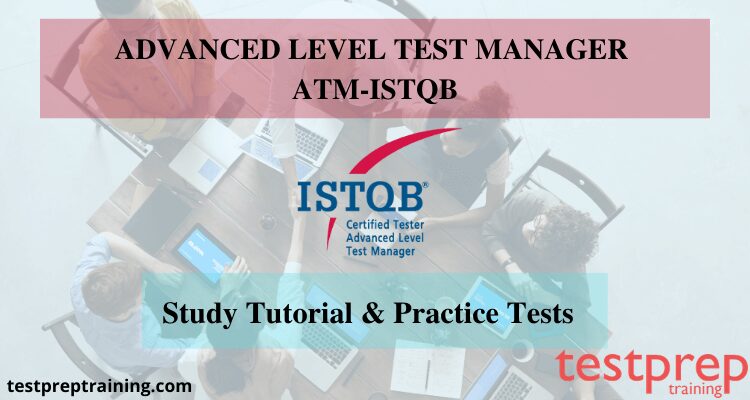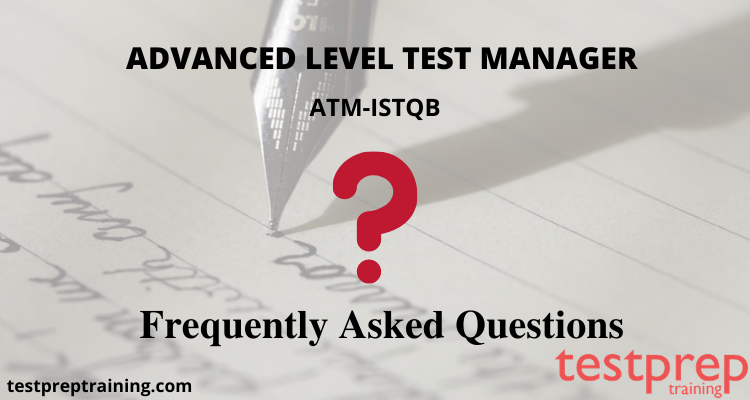ATM-ISTQB | Advanced Level Test Manager

The training course of the ISTQB Advanced Tester Certification – Advanced Level Test Manager (ATM-ISTQB) expands on the test techniques and methods introduced in the certification course of the ISTQB Foundation and addresses those areas of the advanced ISTQB syllabus specifically related to the certification of Advanced Test Management. The course focuses on the key areas vital to successful test management, the testing process, test management, procedures for the enhancement of standards and tests, assessments, defect management, testing tools & automation, incident management, and people skills.
Why become an Advanced Level Test Manager?
The Advanced Level Test Manager (ATM) course will increase your employment opportunities and will also help you get the desired position in the firm. There are private and public companies hiring an Advanced Level Test Manager for their company hence this certification Will help you achieve success in every way.
Target Audience
Anyone wishing to take the Advanced Level Test Manager ISTQB Accredited Tester can take this certification exam. Test Supervisors, Test Leaders and Managers of the Test Program,Testers who want to enhance their skills in methodologies and methods for test management can also take this exam. Anyone who is involved in software project research programmes (including testers, engineers, analysts, consultants, software developers, customers, everyone).
Roles and Responsibilities of an Advanced Level Test Manager (ATM-ISTQB)
You must plan for all the challenging tasks you may face after the certification, so here is a list of the responsibilities undertaken by an Advanced Level Test Manager.
- To Manage a testing project through the implementation of the mission, objectives and testing processes set up for the testing organisation.
- To Organize and conduct sessions for risk identification and risk analysis and use the results of such sessions for the estimation, planning, monitoring and control of tests.
- To Consistent with organisational policies and test procedures, develop and execute test plans.
- To test activities are continuously monitored and controlled to achieve project goals.
- To undertake Evaluation and reporting of appropriate and timely test status to project stakeholders
- To Identify skills and resource gaps and engage in the sourcing of adequate resources in their test team.
- To Propose a business case for test activities that details the projected costs and advantages.
Advanced Level Test Manager (ATM-ISTQB) Interview Questions
ISTQB Advanced Test Manager: Exam Format
| Exam Name Advanced Level Test Manager | Exam Code ATM |
| Exam Duration 120 mins | |
| Exam Type Technical | Number of Questions 45 Questions |
| Eligibility/Pre-Requisite As suggested* | Exam Fee Rs. 4580 |
| Exam Language English | Pass Score 65% and above |
ISTQB Advanced Level Test Manager exam fees in India is Rs. 4580+. The ISTQB Advanced Level Test Manager exam questions can be in Multiple-choice and multiple-response types.
For More Details See – ATM FAQ – Advanced Level Test Manager

ISTQB Advanced Level Test Manager Course Outline
The Advanced Level Test Manager (ATM-ISTQB) certification exam covers the following chapters –
Testing Process
Test Planning, Monitoring, and Control
- K4) Analyze the test needs for a system in order to plan test activities and work products that will achieve the test objectives
Test Analysis
- (K3) Use traceability to check completeness and consistency of defined test conditions with respect to the test objectives, test strategy, and test plan
- Explain the factors that might affect the level of detail at which test conditions may be specified and the advantages and disadvantages for specifying test conditions at a detailed level
Test Design
- (K3) Use traceability to check completeness and consistency of designed test cases with respect to the defined test conditions
Test Implementation
- (K3) Use risks, prioritization, test environment, and data dependencies, and constraints to develop a test execution schedule that is complete and consistent with respect to the test objectives, test strategy, and test plan
Test Execution
- (K3) Use traceability to monitor test progress for completeness and consistency with the test objectives, test strategy, and test plan
Evaluating Exit Criteria and Reporting
- (K2) Explain the importance of accurate and timely information collected during the test process to support accurate reporting and evaluation against exit criteria
Test Closure Activities
- (K2) Summarize the four groups of test closure activities
- Implement a project retrospective to evaluate processes and discover areas to improve
Test Management
Test Management in Context
- (K4) Analyze the stakeholders, circumstances, and needs of a software project or program, including the software development lifecycle model, and identify the optimal test activities
- (K2) Understand how software development lifecycle activities and work products affect testing, and how testing affects software development lifecycle activities and work products
- (K2) Explain ways to manage the test management issues associated with experience-based testing and non-functional testing
Risk-Based Testing and Other Approaches for Test Prioritization and Effort Allocation
- (K2) Explain the different ways that risk-based testing responds to risks
- (K2) Explain, giving examples, different techniques for product risk analysis
- (K4) Analyze, identify, and assess product quality risks, summarizing the risks and their assessed level of risk based on key project stakeholder perspectives
- (K2) Describe how identified product quality risks can be mitigated and managed, appropriate to their assessed level of risk, throughout the lifecycle and the test process
- (K2) Give examples of different options for test selection, test prioritization and effort allocation
Test Documentation and Other Work Products
- (K4) Analyze given samples of test policies and test strategies, and create master test plans, level test plans, and other test work products that are complete and consistent with these documents
- (K4) For a given project, analyze project risks and select appropriate risk management options (i.e., mitigation, contingency, transference, and/or acceptance)
- (K2) Describe, giving examples, how test strategies affect test activities
- (K3) Define documentation norms and templates for test work products that will fit organization, lifecycle, and project needs, adapting available templates from standards bodies where applicable
Test Estimation
- (K3) For a given project, create an estimate for all test process activities, using all applicable estimation techniques
- (K2) Understand and give examples of factors which may influence test estimates
Defining and Using Test Metrics
- (K2) Describe and compare typical testing related metrics
- (K2) Compare the different dimensions of test progress monitoring
- (K4) Analyze and report test results in terms of the residual risk, defect status, test execution status, test coverage status, and confidence to provide insight and recommendations that enable project stakeholders to make release decisions
Business Value of Testing
- (K2) Give examples for each of the four categories determining the cost of quality
- (K3) Estimate the value of testing based on cost of quality, along with other quantitative and qualitative considerations, and communicate the estimated value to testing stakeholders
Distributed, Outsourced, and Insourced Testing
- (K2) Understand the factors required for successful use of distributed, outsourced, and insourced test team staffing strategies
Managing the Application of Industry Standards
- (K2) Summarize sources and uses of standards for software testing
Reviews
Management Reviews and Audits
- (K2) Understand the key characteristics of management reviews and audits
Managing Reviews
- (K4) Analyze a project to select the appropriate review type and to define a plan for conducting reviews, in order to ensure proper execution, follow up, and accountability
- (K2) Understand the factors, skills, and time required for participation in reviews
Metrics for Reviews
- (K3) Define process and product metrics to be used in reviews
Managing Formal Reviews
- (K2) Explain, using examples, the characteristics of a formal review
Defect Management
The Defect Lifecycle and the Software Development Lifecycle
- (K3) Develop a defect management process for a testing organization, including the defect report workflow, that can be used to monitor and control a project’s defects throughout the testing lifecycle
- (K2) Explain the process and participants required for effective defect management.
Defect Report Information
- (K3) Define the data and classification information that should be gathered during the defect management process
Assessing Process Capability with Defect Report Information
- (K2) Explain how defect report statistics can be used to evaluate the process capability of the testing and software development processes
Improving the Testing Process
Test Improvement Process
- (K2) Explain, using examples, why it is important to improve the test process
Improving the Test Process
- (K3) Define a test process improvement plan using the IDEAL model
Improving the Test Process with TMMi
- (K2) Summarize the background, scope and objectives of the TMMi test process improvement model
Improving the Test Process with TPI Next
- (K2) Summarize the background, scope and objectives of the TPI Next test process improvement model
Improving the Test Process with CTP
- (K2) Summarize the background, scope and objectives of the CTP test process improvement model
Improving the Test Process with STEP
- (K2) Summarize the background, scope and objectives of the STEP test process improvement model
Test Tool and Automation
Tool Selection
- (K2) Describe management issues when selecting an open-source tool
- (K2) Describe management issues when deciding on a custom tool
- (K4) Assess a given situation in order to devise a plan for tool selection, including risks, costs and benefits
Tool Lifecycle
- (K2) Explain the different phases in the lifecycle of a tool
Tool Metrics
- (K2) Describe how metric collection and evaluation can be improved by using tools
People Skills
Individual Skills
- (K4) Using a skills assessment spreadsheet, analyze the strengths and weaknesses of team members related to use of software systems, domain and business knowledge, areas of systems development, software testing and interpersonal skills
- (K4) Analyze a given skills assessment for a team in order to define a training and skills development plan
Test Team Dynamics
- (K2) For a given situation, discuss the necessary hard and soft skills required to lead a testing team
Fitting Testing Within an Organization
- (K2) Explain options for independent testing
Motivation
- (K2) Provide examples of motivating and demotivating factors for testers
Communication
- (K2) Explain the factors that influence the effectiveness of communication within a test team, and between a test team and its stakeholders
ISTQB Advanced Test Manager Study Guide
How do I prepare for ISTQB Advanced Level Test Manager? Preparing the right strategy with the relevant set of resources is the most important step to take before an exam. A study guide makes it simpler for you, as all the things you have to do before are prepared, all you have to do is execute the steps mentioned in the guide. All the essential resources that you need for the ATM-ISTQB examination are listed in it.

Learning Resource 1: Official Website
Going through the official website and research content is an important aid in the preparation as it will help in gathering ISTQB Advanced Level Test study material. The resources available on the official website are readily accessible source modes and are thus approached by most people. Going through the stuffs given will increase your level of thinking in accordance with the requirements of the exam. Below are some of the resources which the ISTQB website has to offer to the candidates taking the ATM exam.
Learning Resource 2: Books
Books are the next resource in our guide to planning. Books hold much of the stuff in them. It gives you all the necessary information you need about a subject. So always give the book the first choice before referring to any tool first, as they are the most credible source of information. The following are 3 books that can be referred to for this credential.
Advanced software testing: This book is written for a technical test analyst who wishes to learn advanced test analysis, design and execution skills. This book shows you how to identify and carry out the tasks needed to execute a test strategy with a hands-on, exercise-rich approach
The Expert Test Manager: Guide to the ISTQB Expert Level Certification by Rex Black: This book covers the syllabus of the ISTQB Expert Level Test Manager and is a complete, one-stop preparation guide for the reader who is otherwise qualified to take the Expert Level Test Manager examination (based on experience as a test manager). Extensive hands-on experiments and sample test questions that comply with ISTQB requirements for Expert Level examinations are included.
Managing the Testing Process by Rex Black: In this version of his best-selling book, Rex Black guides you on how to create critical tools and apply them to your test project. An updated edition of the best tips and tools to prepare, build, and conduct an organized test operation.
Learning Resource 3: Join ISTQB Community
Joining an online forum is a nice way for the students to discuss their issues and get insights into how their competitors are going for the exams. Also, multiple viewpoints make the stuff more dynamic. These discussions make the studies more comprehensive. So you must join the ISTQB community if you are serious about your exam preparation.
Check Your Progress with Practice Tests
Applicants must not forget to try their hands-on practice tests to measure their progress and to make sure of their preparation for the Advanced Level Test Manager exam. The examination atmosphere will make you comfortable and will improve your confidence. ISTQB Advanced Test Manager practice test will reinforce your training and sharpen your mind to recall things.


